If you’re using cable internet and paying more than you’d like, you may be able to drastically reduce your internet bill by switching to newer technologies like fiber or 5G wireless home Internet.
In this article, I’ll talk about my experience with Verizon 5G Home Internet, a wireless solution for home Internet access. Note, this is NOT the same as Verizon FIOS, which is a fiber optic cable solution.
I want to stress that THIS IS NOT A SPONSORED POST! I paid for Verizon’s 5G Home Internet service myself because I wanted to find a cheaper, more reliable alternative to cable Internet and share the experience with y’all!
What Is Verizon 5G Home Internet?
With Verizon 5G Home Internet, you get your Internet access through an Internet gateway box that communicates with the nearest Verizon cell tower wirelessly. It’s very much like using a cell phone as an Internet hotspot. The Verizon Internet Gateway box even has a phone number assigned to it! If this sounds disconcerting to you, it did to me also. Could this have as much bandwidth as a direct cable connection? Keep reading.
Cost – Updated August 2023
In August 2023, Verizon changed its pricing structure. The lowest plan is $60/month or $50/month with autopay, limited to 100 Mbps download speed. That is still a good deal for many folks, since 100 Mbps is plenty of bandwidth for households with one or two people.
If you have a qualifying Verizon wireless plan you can pay as little as $35/month.
If you want up to 300 Mbps download speeds, you can get the 5G Home Plus plan for $80/month or $70/month with autopay, or $45/month with a qualifying cellular plan.
Setup and Installation
A few days after I ordered the service, I received the Verizon Home Internet Gateway, a clean white cube with a power jack and two Ethernet ports… and no cable going to Verizon!
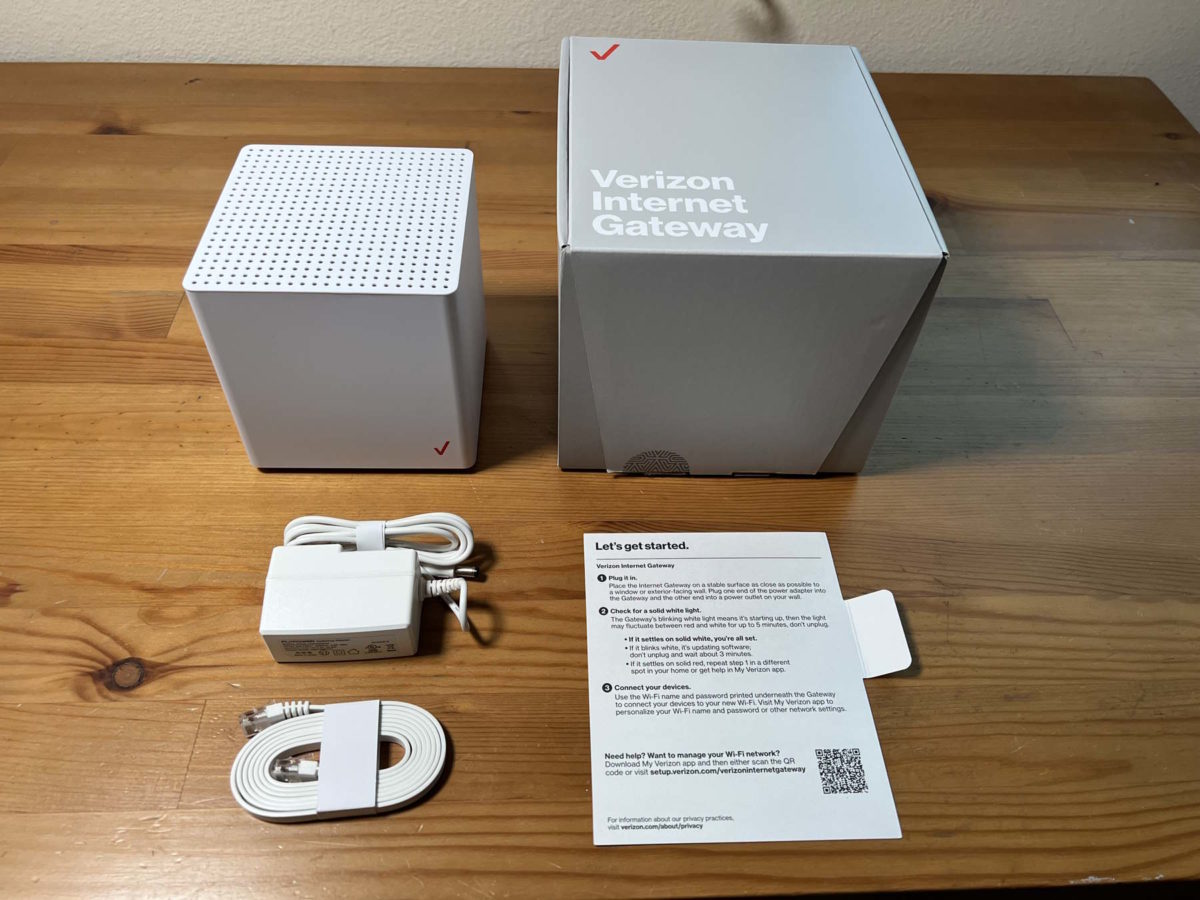
I wasn’t even aware of this when I ordered the service, but the unit includes a built-in Wi-Fi router! I also love the fact that the box has two Ethernet ports. That should make it unnecessary for a good number of people to have to buy an additional router.
Setup was stupidly easy. I plugged in power and waited for it to boot up and configure. When it was done, I connected an Ethernet cable from the gateway to my computer and used the web app to set up my Wi-Fi network name and password. Voila! I was up and running in minutes! Wow!
You can also set up the box via Wi-Fi using the settings printed at the bottom of the unit.
Aside from the quick start card, no manual was included with the unit. But you can download the manual for the ARC model or for the ASK model.
My Download Speed
I immediately measured download speeds of 300 Mbps – the max speed of my plan! I was amazed to be getting this from basically a cell phone signal! Note that the cheapest plan is now limited to 100 Mbps, but this is still plenty of bandwidth for most people.
I’ve been using the service for almost a year now and my typical download speed is between 240 and 280 Mbps. Still better than cable for me.
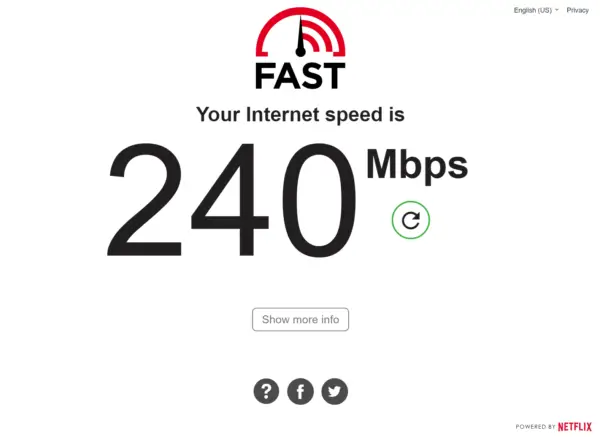
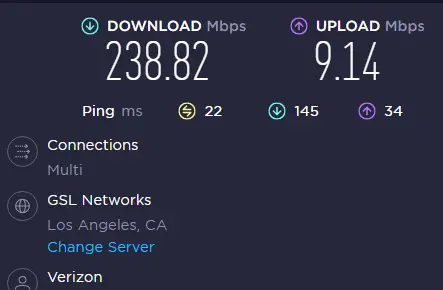
Over the past year, my cable download speed had been around 90mbps, probably due to deteriorating coax cabling in my home. That was one of the things that made a wireless Internet solution appealing to me. Note that other folks are able to get faster Internet speeds with cable.
I must stress though that your mileage may vary depending on how far away you live from your closest cell phone towers and how many other people are using that tower at that time.
And, not everyone can get 5G Home Internet. Check the Verizon website to see if you’re in range.
The Built-In Wi-Fi Router: Understanding Its Limits
Because the Verizon Home Internet Gateway box includes a built-in Wi-Fi router, I went ahead and tried it out. For the first month, it worked great, with good signal strength that reached throughout my two-story home and even into my garage below that. After a month though, my signal strength inexplicably fell off a cliff. I noticed it when my outdoor Ring cameras went dead due to low Wi-Fi signal. Inside my home the signal strength was fine.
I can’t explain the sudden dropoff. Perhaps there was some new signal interference from a neighbor?
In any case, I’m not really counting this against Verizon, because I wouldn’t expect a built-in Wi-Fi router with no external antennas to have as good a range in a two-story home as a dedicated Netgear router with three external antennas!
If you live in a one-bedroom apartment or a single-story home, the built-in Wi-Fi router probably will be just fine for you. It will probably work in a lot of two-story homes as well.
But, a lot of the low online ratings for Verizon Home Internet stem from complaints about the Wi-Fi range. Well, the built-in gateway router is not intended to be as good as a dedicated Wi-Fi router with external antennas that you can get at Best Buy. If you live in a large multi-level home you’ll probably want to use a dedicated router made by Netgear, Asus, or other reputable manufacturers.
In addition, I’ve read that the onboard Wi-Fi router is limited to 10 devices at 2.4GHz and 30 devices at 5.0GHz. Again, the solution is to hook up your own Wi-Fi router as described next.
I had one commenter, Tom, tell me that he complained about the Wi-Fi range to Verizon and they sent him a Wi-Fi extender, free of charge! Something to try if you don’t mind waiting on hold with customer support.
Using an External Wi-Fi Router
Connecting an external Wi-Fi router to your Verizon Home Internet gateway is pretty easy.
You’ll want to do this using a device with an Ethernet port (i.e., don’t rely on Wi-Fi to do these settings). The reason is that you’ll be shutting off Wi-Fi on your gateway, and if anything goes wrong and you need to turn it back on, the only way to do that is to use Ethernet.
On the Verizon Gateway web portal, go to Network -> LAN -> IP Passthrough and turn it on. Once you do that, Wi-Fi will be turned off and Internet access will be routed out of the LAN2 port of the gateway. Plug in your router into that port and you should be good to go! Read my full instructions here.
The Bad: Creating My Account
As soon as I submitted my order for the service, I got an email prompting me to create a Verizon account online. When I tried to do so, the website didn’t recognize my device phone number or my account number. I called Verizon customer service and they advised me to wait for the gateway to arrive and set that up first before setting up an account.
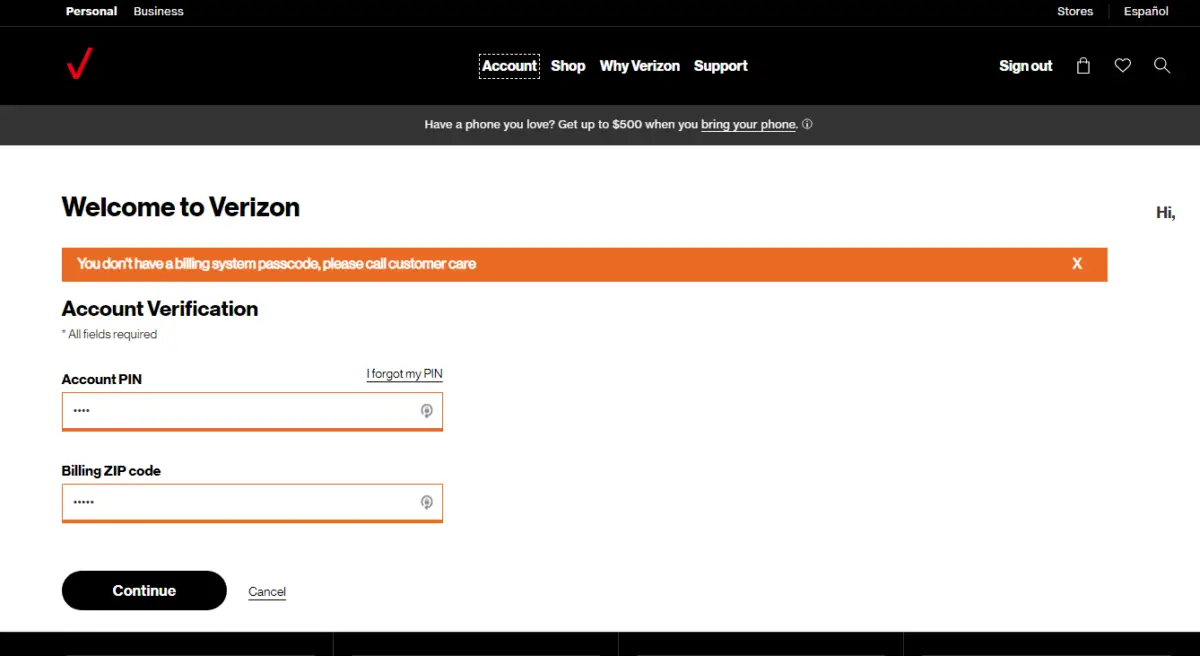
So, I did that but got the same error. I tried logging in so many times that my account got locked, so I called again and they reset my account. Unfortunately, the reset code had to be sent by regular U.S. Mail because the phone number on file was that of my gateway, which of course is unable to receive text messages. Agh!
After that, I could finally log into the website and set up automatic billing (which you need to do to get the $10 monthly discount on the service). But, I still couldn’t log into the iPhone app. I called again, and they reset my account yet again, which meant waiting for another code in the mail.
That didn’t solve the problem either. At this point, I resigned to just using the website. There are also some settings that just time out when I try to change them, like the contact phone number. I was only able to change this by calling customer service yet again.
This was just my experience; I know others have had a seamless account creation experience. My issues might be due to the fact that I used to have a Verizon wireless cell phone account a long time ago because I saw this message on the site: “This email is linked to another line on this account. You’ll need to login to that line to manage preferences.” I’m guessing it’s getting confused with my old account.
To their credit, it was always pretty easy to get a Verizon customer service agent on the phone, something that can’t be said for all Internet providers.
Inaccurate IP Address Geo Location
Some folks who watch local TV channels on streaming services like Hulu and YouTube TV have reported that their location is not reported correctly to these services and therefore they are not able to watch their local channels on these services.
There are two dimensions to this problem.
The first is that Verizon is expanding rapidly and using new IP blocks that have not been updated with the correct location yet in the IP Geo Location databases. Eventually, these will be corrected.
If you go to https://iplocation.io/, you can enter your IP address (Google “what is my IP address”) and see what location that IP is pegged to. You can also do the same thing at the MaxMind website. If your location is incorrect, you can submit a request for correction there as well.
The second issue is that the IP address of the gateways is not fixed, so it may change. You might have an IP address with the correct location one day and one with the wrong location the next.
One solution to these issues is to use a VPN service with an IP address geo-located in your area.
So, just something to consider if you stream local TV channels. Personally, I use a TV antenna for local channels so I don’t have this problem, but not everyone can get broadcast TV signals.
Reliability vs. Coax Cable Internet
Despite the account creation headaches, I still like Verizon’s actual 5G Internet service overall. So far, it’s been fast, reliable, and trouble-free, and it has saved me hundreds of dollars in the first year.
I believe that using CATV coax cable to send high-speed data is going to go obsolete, kind of like DSL. With DSL, data was being sent over analog phone lines, something not intended for that purpose. Similarly, with cable, high-speed data is being sent over coax originally intended for analog TV signals. I believe the current ideal methods for sending high-speed data are either fiber or 5G wireless.
We’ll see what happens, but I’m betting that 5G will be more reliable than cable Internet.
My cable Internet would go down at least a few times a year, for a few hours at a time. I don’t blame the cable company for that though; it’s just the nature of physical cables that they are prone to breakage if a tree knocks down a telephone pole, or whatever. And It takes time for the cable company to find the fault, and send a truck out to fix it. A few hours of downtime is pretty good.
Another thing is that cable Internet will go down whenever the power goes out. My building has a powered junction box for cable, and when that loses power, Internet for the whole building goes out. With 5G, if you can power your gateway box, you might still be able to have Internet access. Check out this story from reader Peter:
I got Verizon 5G internet around Christmas, and it is working great. I still have Comcast, because I refuse to cut the cable TV cord. But during a recent storm and 3-day local power outage, the Verizon internet continued working, while the Comcast went down until PG&E power was restored. We have a backup generator, but without Internet or cable TV it can get lonely.
I’m hoping that cell towers will be more resistant to interruptions due to high winds, storms, earthquakes, and so on. So far it seems so.
Perks?
Finally, Verizon offers various perks for signing up. When I signed up, they offered a $50 DoorDash food delivery service gift card and a $50 Verizon gift card. Note that you have to register to get these perks after you create your account, or else you won’t get them. It’s unfortunate that they don’t come automatically.
My Doo Dash gift card (actually, it is an email with a discount code) arrived very quickly, within a few days if I remember correctly.
The Verizon “gift card” took over thirty days to arrive by email, but there is a portal where you can check status. I was hoping I could use this “gift card” on anything, like a debit card, but it really is just a $50 discount code for the Verizon store. I used it to buy a phone charger and cable since I’m always using those. But again, the Verizon store website was terrible, and it was hard to find where to enter the code, and even after I did, the site eventually “lost” my gift card balance. I got on chat and completed the order manually through them, but it was a hassle.
Verizon 5G Home Internet – Should You Get It?
Despite these website issues, Verizon 5G has been a good deal for me and I’m saving $30/month. If you’re sick of the rising cost of Internet access, and you’re getting Internet from a cable TV provider, I would recommend checking to see if you can get 5G Internet access from Verizon or T-Mobile.
Just keep in mind that while Verizon 5G works great for most people, it doesn’t work for some people in some locations. So, don’t cancel your existing service immediately when you get Verizon! Keep your old ISP for the first month. If Verizon doesn’t work for you, cancel it and revert to your old ISP. I don’t recommend messing around with Verizon customer support for very long. If they can’t solve it pretty quickly, cancel it.
I’ll keep this article updated with any new developments, and you can check out my YouTube channel for quarterly updates on my Verizon 5G experience!
Pros
- May be cheaper and more reliable than cable (depending on your location).
- No cost increases for 2 years (depending on current promotions).
- Easy to set up Internet gateway.
- Built-in Wi-Fi and Ethernet router is sufficient for small homes and apartments.
Cons
- Not available in all locations; speed may vary according to your location.
- Verizon’s account creation process didn’t work well for me. Website and app are terrible.
- Customer service is reachable but not always able to solve your problem. Should keep your old ISP while you evaluate Verizon.
How much are you paying for Internet access? Any questions or comments? Leave a comment below! – Brian
If You’re Really Crazy About Speed (ADVANCED)
A commenter on my YouTube video turned me on to this company that sells products that get you the fastest cellular speeds, including on home 5G gateways.
If you have the ARC-XCI55AX gateway, it turns out that you can hack it to add an external antenna! That would really maximize your data rates.
If, like me, you have the ASK-NCQ1338/FA/E gateway, you can’t attach an external antenna. However, you can put your SIM card into a different router that can handle an external antenna.
Needless to say, do these at your own risk! I’m sure these would invalidate any kind of warranty on the device. I’m way too scared to try these because I work from home and can’t afford to have my Internet go down. But, these are some pretty cool ideas!
Oh, and here’s an article from that same company on how to tell where your 4G and 5G cell towers are.
Verizon 5G Home Internet 90 Days Later
Wondering how Verizon 5G Internet is holding up after 90 days? Watch the video below:

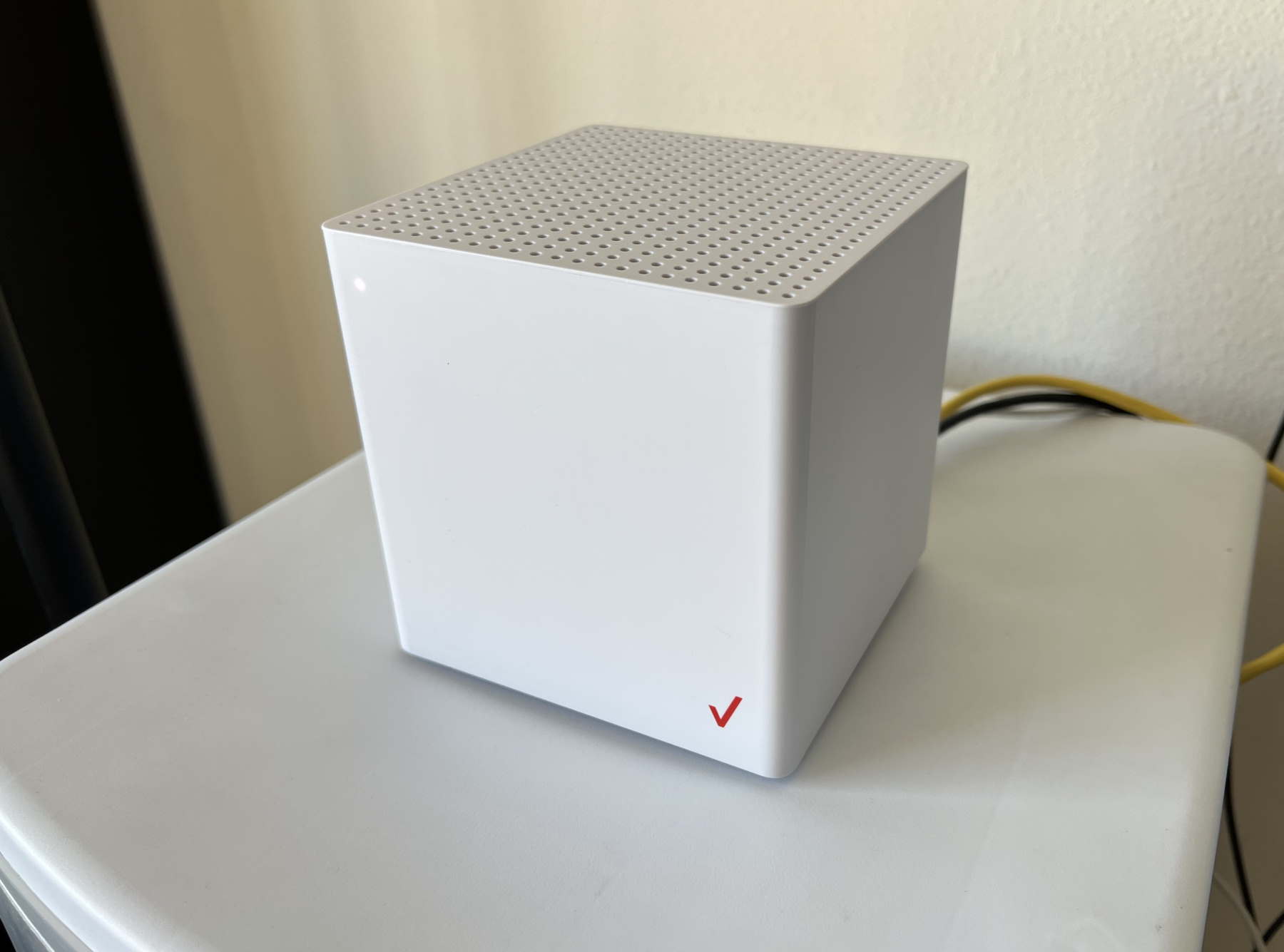

How has your Verizon internet been after the Cloudstrike event? I am currently trying Verizon internet, but still have xfinity. I had a couple hickups where the TV was not receiving a signal or would not recognize the Wi-Fi. I also had disconnects from only having a few devices, 3 or less from the Wi-fi.
Hi Jim,
I didn’t have any problems with my Verizon 5G Home Internet after the Cloudstrike event. Was rock solid.
Best,
Brian
Hi, thanks for all the tips, I am confused how it works to keep existing internet provider and also have Verizon, but I love that option as I work from home also and absolutely need to know internet is reliable for me from Verizon before canceling the other. How does it work to have 2 at the same time? I have a Netgear router currently and would want to use it for the new service can they both be tied to it? I am a novice at this, so any advice is most appreciated, thanks Jen
Hi Jen,
After your Verizon gateway arrives, you could simply plug your Netgear router into it instead of your existing provider’s box.
The Verizon gateway does come with its own Wi-Fi router, but your Netgear router is almost certainly better. You can turn off the Verizon gateway’s Wi-Fi.
Best,
Brian
I appreciate your article as I’m going to change from CenturyLink DSL because it’s going to be phased out and my Net Gear router is no longer supported and the CenturyLink modem is going to be discontinued also. I have Verizon phones which isn’t cheap so I don’t know if I would go their route.
We live in Maricopa, Az which has limited providers but Cox fiber came in recently so that is one possibility. They give you a great first two year rate$50 a month) then at the end of that it jumps to ($135 a month)!!!
I need some advice if you have any.
Hi Bob,
Verizon 5G Home Internet is still working great for me after 1.5 years at $50/month. It works well for most people but it does depend on how far the towers are from you and other factors. Also, their customer service isn’t great, to put it mildly.
I’d recommend giving it a try for a week, leaving your existing Internet service in place. If it doesn’t work for you, return everything.
If you do have Verizon phones, you get a pretty big discount on their 5G Home Internet; another reason to try it.
Best,
Brian
During your local 3-day power outage, how did your Verizon Internet Gateway continue operating, since it is powered by your 120V wall plug—fed by your local electric supplier (which was supposedly not working)? Thank you
Hi Terry,
That reader, Peter, had a power generator.
Best,
Brian
How does Verizon internet compare to T-Mobile internet (which I have now)? I’m very happy with T-Mobile, especially their customer support, it’s exemplary. Occasionally there will be a short (.5 second) blip where the signal is interrupted. It doesn’t happen enough to be annoying. Other than that I have no complaints except that the bill is going up. It was originally $50/mo for life! Retired, disabled, fixed income and not a lot of good options for ISP in Tucson, AZ. So I’m shopping around.
Hi Naomi,
That’s hard to answer since it is highly dependent on location. If you have a strong T-Mobile signal, you may not have a strong Verizon signal, or vice versa. Try checking with neighbors in your area. I will say that lots of people complain about Verizon customer service, so if you are happy with T-Mobile’s, that could be a big advantage.
Best,
Brian
Thank you. Last time I moved T-Mobile said my new address wasn’t in their network but told me to try plugging in their equipment at the new place. It worked! So I’m going to try that again.
Could not get it to work, Verizon set up for a tech to come out to hook up, tech was rude very unprofessional, told my sister she needed to make him lunch and cookies,
Wanted to break a window. Got made and left off job with getting it working , called in to report and had to reschedule for 2 days later,
Same tech came out to work on didn’t see me at first and was rude to my son out on the sidewalk and when I questioned his attitude he got really nasty and told my son to shut the F@#% up, I started after him and he walked off the job again, had to reschedule a 3rd time with another tech, told Verizon I would not let the same tech on premises, 3rd tech called and never showed
Wow, wow that is totally crazy! Thanks for sharing. You can also post on their ads on Facebook; they do look at those comments. – Brian
I was supposed to get a call back from customer service last Friday after they had conversation with the tech, still no word back ,
Very helpful information, thanks!
Hi,
My job allows me to work remotely from home, but we handle confidential documents. Is this type of internet safe to protect sensitive data I will be receiving and sending from my home (work) computer?
Hi Jennifer,
That is a great question. The level of security of Verizon 5G Home Internet is exactly the same as if you’re using 5G on your cell phone. In other words, if you’re already sending work email using your phone, you’re already at the same level of security.
But how secure is 5G itself? Of course it can be hacked. But I would say your local Wi-Fi network and router are more vulnerable than the 5G wireless network.
If you work in the medical industry, you’ll know that they are super concerned with privacy (HIPAA compliance). But even that industry has no problem with the transmission of private data over 5G.
I personally don’t see 5G as an unreasonable security risk, and I depend on it for my own work.
Having said all of this, I’m not a security expert, so if your job requires an unusual amount of security (like NSA or something like that!), you might want to do further research (and let me know what you find out if you do!)
Thanks for your question,
Brian
Use a VPN for security.